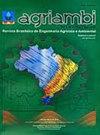免耕制度参与性质量指标
IF 1.4
4区 农林科学
Q3 AGRICULTURAL ENGINEERING
Revista Brasileira de Engenharia Agricola e Ambiental
Pub Date : 2020-02-01
DOI:10.1590/1807-1929/agriambi.v24n2p128-133
引用次数: 12
摘要
免耕制度参与质量指数旨在评价免耕制度下土壤管理的质量和效率,由作物轮作强度、作物轮作多样性、作物残留在土壤表面的持久性、土壤耕作频率、梯田利用、土壤保持评价、土壤施肥平衡和采用免耕制度的时间8个指标加权和而成。本研究的目的是评估这些指标与免耕系统参与质量指数的相关程度,并确定参与研究的农民的特征。采用ITAIPU Binacional提供的免耕系统参与质量指数II的指标数据。进行描述性分析,计算各指标与指标间的Pearson相关系数。采用主成分分析和聚类分析对指标与农户行为之间的关系进行了分析。尽管在p值≤0.05时,所有相关性均显著,但有些相关性较弱,表明该指标有待改进。主成分分析确定了三个主成分,它们解释了66%的数据变异性,聚类分析将121名农民分为五组。验证了免耕系统参与质量指标II存在一定的局限性,应重新评价,提高其作为免耕系统质量指标的有效性。本文章由计算机程序翻译,如有差异,请以英文原文为准。
No-tillage system participatory quality index
ABSTRACT The no-tillage system participatory quality index aims to evaluate the quality and efficiency of soil management under no-tillage systems and consists of a weighted sum of eight indicators: intensity of crop rotation, diversity of crop rotation, persistence of crop residues in the soil surface, frequency of soil tillage, use of agricultural terraces, evaluation of soil conservation, balance of soil fertilization and time of adoption of the no-tillage system. The aim of this study was to assess the extent to which these indicators correlate with the no-tillage system participatory quality index and to characterize the farmers who participated in the research. The data used were provided by ITAIPU Binacional for the indicators of the no-tillage system participatory quality index II. Descriptive analyses were performed, and the Pearson correlation coefficient between the index and each indicator was calculated. To assess the relationship between the indicators and the farmers’ behavior toward the indicators, principal component analysis and cluster analysis were performed. Although all correlations are significant at p-value ≤ 0.05, some correlations are weak, indicating a need for improvement of the index. The principal component analysis identified three principal components, which explained 66% of the variability of the data, and the cluster analysis separated the 121 farmers into five groups. It was verified that the no-tillage system participatory quality index II has some limitations and should therefore be reevaluated to increase its efficiency as an indicator of the quality of the no-tillage system.
求助全文
通过发布文献求助,成功后即可免费获取论文全文。
去求助
来源期刊

Revista Brasileira de Engenharia Agricola e Ambiental
Agricultural and Biological Sciences-Agronomy and Crop Science
CiteScore
2.70
自引率
16.70%
发文量
114
审稿时长
3-8 weeks
期刊介绍:
A Revista Brasileira de Engenharia Agrícola e Ambiental (Agriambi), periódico oficial da Asociación Latinoamericana y del Caribe de Ingeniería Agrícola (ALIA), é editada mensalmente, no formato eletrônico, pela Unidade Acadêmica de Engenharia Agrícola (UAEA) do Centro de Tecnologia e Recursos Naturais (CTRN) da Universidade Federal de Campina Grande (UFCG), destinando-se à divulgação de artigos científicos originais e inéditos, elaborados em Português, Inglês ou Espanhol. Com o auxílio de pareceres de Consultores, os artigos são aceitos ou não pela Equipe Editorial para publicação na Revista. A Agriambi aceita, também, a submissão de contribuições na modalidade de revisão de literatura.
 求助内容:
求助内容: 应助结果提醒方式:
应助结果提醒方式:


